Radio Caroline Lands At a Famous Home
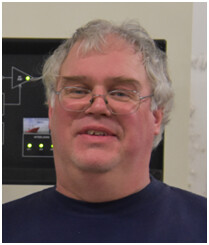
Since 1991 when numerous circumstances brought the stations ability to operate freely offshore to an end, the Caroline ship, MV Ross Revenge came to port in several cities in England for periods of local broadcasts and tours. By the turn of the millennium Caroline had steamed onto the Internet and digital platforms, but never forgot the power of a powerful AM transmission. And now, after six decades, it has come fully ashore, to a famous place both on land and on the dial. Alan Beech who has been an engineer with Radio Caroline for over two decades tells us the story.
After a seven or eight year campaign, getting the support of various UK MP’s and other important people, and submitting an application for a “community” radio license, we were given some positive feelings that it would be accepted. So we stood back and waited.
In May 2017 Radio Caroline was awarded 648 kHz, the former BBC World Service frequency for Europe.
Whereas most community stations operate at around 100 Watts or so, and are expected to cover a small neighborhood, we stuck our neck out a little and asked for 1 kW, and it was granted! Considering that 1 kW was down at the low end of the band, we expected somewhat better than usual coverage.
We later found out the regulator, OFCOM, had some serious misgivings and a few of our friends there had to really bat hard to help us win.
Going for a community license rather than a commercial license frees us from some of the regulatory hurdles, but does mean we have to be non-profit (quite an easy task for us!) and cannot rely 100% on advertising and sponsorship (again, not difficult for us) amongst others.
GETTING THE RIGHT SITE
Once we knew we had 648 kHz, our attention turned to the former BBC World Service site at Orfordness.
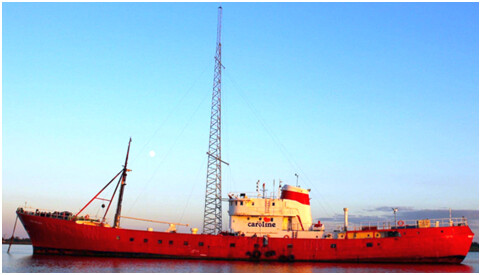
 Although we would have loved to have used the Ross Revenge ship as a base, it was rather impracticable.
Although we would have loved to have used the Ross Revenge ship as a base, it was rather impracticable.
For a start, we cannot guarantee the ships location for an indefinite amount of time, nor that it could be central to the transmission area. Then there are the costs of fuel, crew, and all that. We looked briefly at building a site with a friendly farmer in the coverage area we asked for, but that was more or less just the official line and to detract folks from what we actually planned.
The Orfordness site is on the East coast of England, and originally used a five-tower directional – radiating around 2.5 Megawatts ERP towards Eastern Germany from a 500 kW transmitter. It still is pretty much a clear channel, though there are two others, both 10 kW as far as we can tell – one in Spain and one in Slovenia, both 1000 odd miles away – which can put a good signal into the UK at night.
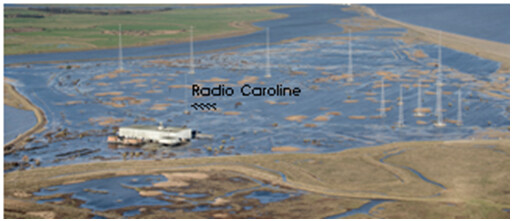
Credit: John Fielding, Creative Commons
Although it was mothballed in 2012, we knew that the building and towers were still on site. It was not perfect, one of the perils of operating on the coast is flooding, as you can see in the picture above. In fact, the site is build on stilts and contains extensive pumping and drainage to recover from incidents like this.
However, we had no idea who owned it, or how we could access it. Was it owned by the BBC, Babcock Networks (BBC transmission partner) or even by the government FCO (foreign and Commonwealth Office) who funded its construction back in the 1970’s. It was a bit like trying to get onto a mothballed VoA site – who the heck do you phone to get a foot in the door?
It was a surprise to find all of the above parties had divested all their interest in the site to two local businessmen who had an interest in historic preservation and all things cold war. (Indeed, the site has a military history going back to Victorian times, and in the 1960’s was a NATO OTHR radar site monitoring Scandinavia and Russia for those incoming nuke missiles so that the 4 minute warning could be issued.)
THE RIGHT PLACE AT THE RIGHT TIME
It turns out the new owners did not really know what to do with the place.
It was almost in the “switch the lights off when you leave” condition after the BBC walked away. The BBC had taken some of the modern equipment (a 200 kW Nautel DRM transmitter), but the original 500 kW 1970’s transmitter was still there, along with some older 250 kW ones, though they had taken the tubes and other useful bits.
To have demolished the site would probably have cost the BBC in the region of millions, so they were probably glad to be able to hand over the keys and walk away.
We had a couple of months of negotiations with the new owners during which money was offered and in November 2017 set foot on site, along with a Nautel ND2.5 we had been “gifted” and the associated bits and pieces.
ALMOST THE PERFECT SITE
The site is on a spit of land, quite literally sticking out into the sea, with no road access, so everything has to go over on ferry boats of various sizes.
It is a bit of a logistical challenge getting there, but it turns out to be the most apt land-based site for a former offshore station.
We plugged our little Nautel into the 6-inch coax feeder going to their low power omni-directional standby mast (only rated for 200 kW!) and switched on at the end of November 2017. We then had to submit the final paperwork and commissioning documents to OFCOM, and finally, the week before Christmas 2017 we were in business.
THE AUDIENCE FOUND US!
We had no idea how successful the service would be – who in their right mind would launch a music service on AM in 2017, when just about everyone else is switching off?
However, we have been pleasantly surprised at the response, not just from regular dedicated listeners who have followed us for years, but many casual listeners too. Almost immediately we were greeted by an absolute flood of reception reports from all over Europe.
I honestly could not believe that 1 kW ould go so far!
TECHNICALLY SPEAKING
That Nautel was a wonderful box at just the right time – it had been taken out of service around 2007 and sat in a garage for 10 years, and was about to go in the dumpster as the owner needed his garage back.
It was actually one of our insiders at OFCOM who brought it to our attention, as he was on an international committee and knew the guy in Switzerland who was about to scrap it. Sometimes it truly is a small world, and some friends in inside places are very useful!
I fitted all new electrolytics to it, swapped out one leaky MOSFET in the power control loop, replaced a couple of discolored resistors, and retuned the PA filter. It then ran for four years without missing a beat. In that time it only had two routine maintenance visits.
MORE POWER, NEWER TRANSMITTER
I say that about the Nautel in the past tense, as in 2019 we were offered, at a very good price (c. $7000), a Harris DX25 which was also in storage in someone else’s garage, where it had been since 2013.
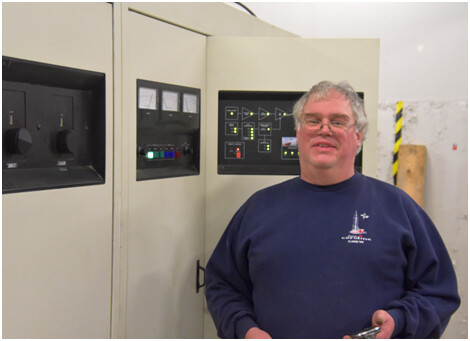
Credit: Lawrie Hallett
We then had to figure out if we could use it productively, so set about submitting a justification to OFCOM for an increase to 10 kW – and crossing our fingers. The fact other stations had switched off AM helped give us some justification, and as we knew we were picking up listeners we calculated that we could afford the extra costs, etc.
COVID and Brexit and others matters slowed things down a lot, but in Spring 2021 OFCOM offered us 4 kW – hardly an ideal level to run a 25 kW transmitter, but it makes a good starting point for asking for more Watts in the future. So, the DX 25 was paid for and shipped over from Holland and I spent a good few long weekends and weeks in a farmer’s barn in Essex (to the East of London) over the Summer getting the thing back to life.
RETUNING DETOUR
The process would have been quicker and less stressful had the two manual we had not had misprints in the PA and filter tuning and frequency change procedures.
Eventually I got in touch with the nice folks at GatesAir (the former Harris Corporation) in Quincy to resolve the issue, and a few days after that, we the DX 25 was up and running!
Of course, a couple of our guys had been busy in the metal fabrication department, building brackets and fittings to fit all the extra capacitors in place (we had to come down the band a fair way), and a lot of that work then had to pulled out and restarted again, once we had the correct tuning information.
POWERING UP
The process was made a bit more fun by the fact the barn to which we had access only had single phase power, but the barn next to us did have 3-phase.

We still do not know who paid the bill (we assume it is the farmer from whom our supporter was renting his barn/workshop), nor how many Amps the supply was rated at, but a length of 3-phase cable mysteriously connected the two buildings together one night when no one was looking. As I worked on the transmitter, I found the power source definitely could certainly manage 30 to 40 Amps when asked without complaint.
Although I only had a 10 kW load available we brought the transmitter power up little by little. As expected when we were running 12+ kW at 130% modulation, a 10 kW dummy gets very warm and this one blew a seal, pouring its coolant all over the floor. In the end, I did wind it up to 15 kW at one point, for just a few seconds, so it all seems to be good.
GETTING IT DONE
A full set of electrolytics, cleaning of all the amplifier module edge connectors, a noisy op-amp in the audio path, and a duff binary TTL counter in the power control circuit was pretty much all that was required aside from the retune.
But my estimate to the Boss of 2 to 3 days to bring up on its original frequency and plan for re-tune, 2 to 3 days to perform the re-tune, and 2 to 3 days of final testing were somewhat optimistic. I think it was June or July when we started – and October when we finished.
The DX was then dismantled once again and shipped over to Orfordness on the big ferry boat over the river, and after 3 to 4 days on site in November, putting it back together, running in some big power and biggish (not 6 inch!) coax, and updates to the audio/control rack, the Nautel was put into standby service.
MORE LISTENERS!
Another flood of reception reports came in, including our first ones from the other side of the Pond (Cape Cod, Maine, and Ontario).
It is quite amazing what 4 kW can do on a fairly clear channel. We have a “first class” signal out to around 140 miles (my definition of first class is stopping the search tune on my car radio) but a usable signal out to 200 miles or more. At night we put a good signal over much of Europe, including Slovenia and Spain where our co-channel neighbors are located!
There is an article on the Radiocaroline.co.uk website about the history of the 648 channel and how it came under our watch, and if you search for “orfordness” or “orfordness radio station” there are many references with much more fascinating history than I can hope to condense into this short article. As we move along, we continue to hope for more power. At the same time, any ND, DX, or Ampliphase parts would be appreciated.
LANDING AT A FAMOUS HOME
The irony of us having access to a former BBC World Service site and clear channel frequency, built and maintained at no expense by the government never ceases to be lost on me. It always makes me smile when I think about it.
Had someone suggested that it could happen at any time more than a few years ago, I would have thought them insane.
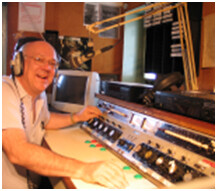
It is also a nice touch that our Gates Dualux desk onboard the Ross Revenge is, after a rather long-winded digital path, feeding a transmitter that came out of the same factory – or at least one reasonably close in the same town – some 60+ years after it was made.
Click here to sign up for the BDR Newsletter and get notice of when other articles are published.
Return to The BDR Menu
